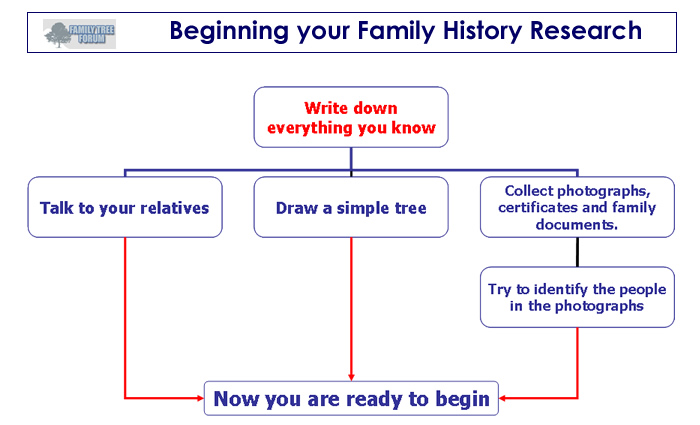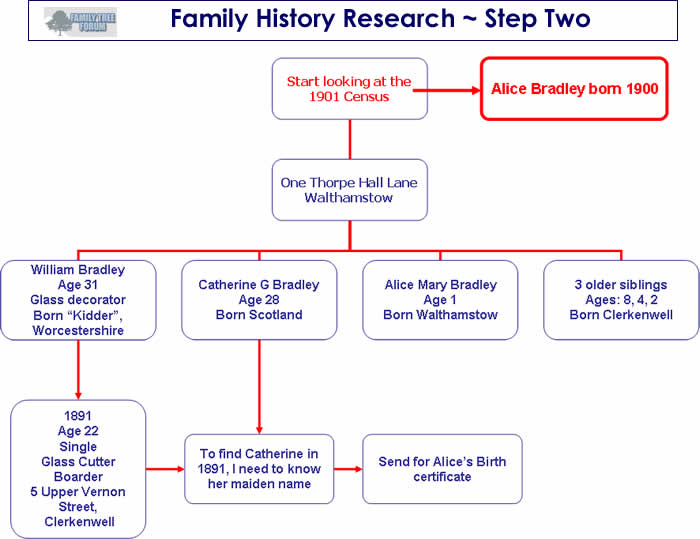Difference between revisions of "Creating Your Family Tree"
| Line 61: | Line 61: | ||
<br><br> | <br><br> | ||
| − | ==Sorting | + | ==Sorting Out Those Relationships ...== |
Who is your 5th cousin twice removed? Can first cousins marry? Can a man marry his wife's sister? Is a man allowed to marry his great-grandmother in Scotland? | Who is your 5th cousin twice removed? Can first cousins marry? Can a man marry his wife's sister? Is a man allowed to marry his great-grandmother in Scotland? | ||
Revision as of 16:33, 24 June 2007
Contents
Beginning Your Research
Before you can start constructing your tree, you need to find the branches and twigs to populate it. This page will give you advice on how to go about it and where to find the information, together with hints and tips on deciding whether they are "yours", using The Wiki pages and external links.
Step One ~ Talk To Your Relatives
The first thing to do when you’re starting out is to write down everything you know about your family – names, dates and places of birth, marriages & deaths etc. Ask your relatives for help, especially the older generation, they’re usually a mine of information and stories. Perhaps take a tape recorder along with you to record what they say. Collect together as many old photos, certificates and other family documents you can find. Try to find out the identities of the people in these photos.
Once you’ve collected all of this information and drawn up a simple tree linking them all together, you’re now ready to trace your family back further.
- Downloadable Blank Charts Seven different layouts for recording your direct line.
- How to store it all... Gives many different ideas on how to organise your information.
Step Two ~ Going Back Before 1900
You may have been lucky enough to have enough information to take you back to 1901 the year when the latest census to be available to genealogists in it’s entirety was taken. You can search the census from the comfort of your computer chair through subscription sites such as Ancestry and other sites which you can find on Online Research. Once you find your known relative, look to see who’s living in the same household – brothers, sisters, parents or even grandparents if you’re lucky. Census returns including names etc were taken every 10 years from 1841, so online you have access to 60 years worth of census records.
Family History Research ~ Step Two This page extends the search for Alice back to 1841.
By tracing back through this method it’s usually easy to be able to trace your family back to those born in the 1700’s!
Write all of this new information down.
The Census Search pages will give you information about Census returns and advice for searching them.
A Visual Guide to Tracking down your ancestors before 1900.
Step three ~ How do you know they "belong" in your tree?
So you think you’ve finished? You’ve only just begun! What you have now is the framework of your family tree. Some of this information might be wrong, perhaps Granny’s memories failing, perhaps the information recorded on the census is incorrect…..
This is when you need to start ordering births, marriage and death certificates. These can be obtained online from the General Record Office or through the local register office (links to WIKI). They’re not cheap - £7 a certificate, but believe me they’re worth it to confirm the links that you have found. You don’t want to be barking up the wrong tree do you?!
These pages will help you find out All About Certificates and how to go about obtaining them.
Finding Those Names
text here
Sorting Out Those Relationships ...
Who is your 5th cousin twice removed? Can first cousins marry? Can a man marry his wife's sister? Is a man allowed to marry his great-grandmother in Scotland?
Find the answers here: Degrees of Kinship
Quick Hints and Tips
- Once you find the census images it’s a good idea to download them to your computer and keep them in a file all together.
And when you have found all the information
Your tree is growing now, perhaps now’s the time to think about getting Family Tree software program to record all of your new found information.
Your tree is looking good now, perhaps it’s time to revisit your relatives to jog some memories and hopefully get some more information and put some more names to faces in those old photos......


